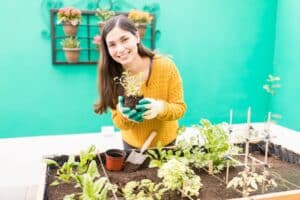Water Your Plants – A Step-by-Step Guide

One of the keys to achieving that mythical green thumb is understanding how to water your plants. It doesn’t matter if you’re talking about an indoor houseplant, hedges across your boundary, or your vegetable garden. A big part of getting these plants to flourish is giving them water.
More specifically, the key to getting them to flourish is giving them the right amount of water. In fact, when you water your plants, you are more likely to hurt them by giving them too much water than not enough of it.
So, how much water is too much for plants? What’s the best way to give water to a plant and how often? Read on for some tips on how to water your plants.
Why Does a Plant Need Water?
You might think the answer is simple and straightforward. But it turns out that there’s a lot going on behind the scenes when it comes to how plant cells function. For example, did you know about photosynthesis? Plants convert carbon dioxide into oxygen with the help of sunlight by using chlorophyll in their leaves to make sugars to help the plant grow. Water supports this mechanism, without it, the plant simply can’t do what needs to do.
Water in the plant helps the plant to maintain its structure. The cells in the plant act like little tiny water balloons holding the water. This is what helps keep the stems straight and give plants their structure. It’s the same reason when a plant doesn’t get enough water, it flops over and looks wilted.
Plants also are constantly going through a process called transpiration. As the sun hits the leaves of a plant, it evaporates water through the leaves. The plant then knows to send water from the roots where it’s gathered to the part of the plant where it’s most needed.
Water Your Plant Basics
So, now that you know how a plant uses water, you need to know how much water to give the plant (especially since overwatering is a common problem) and how often to water too. The simplest answer to all water-related questions for your plants is that it will depend on the plant itself. Just like plants vary by the amount of sunlight they need to grow, water needs vary by plant too.
There are a few basic things to know as it relates to watering. When you re-pot a plant or put a plant in the soil for the first time, you should always give it some water.
Not only will the actual plant type impact how much water to give, but it will also vary depending on the size of the pot the plant is in. Larger pots will take longer to dry and therefore will not need to be watered as frequently as plants in smaller pots.
Consider the location of the plant when you water your plants. Plants that are in bright sunlight will dry out more quickly and likely need more water than plants that grow with less light. If you keep your home more humid or live in a humid region, plants will need less water because they won’t dry out quickly.
Consider Your Plants Origin for Water Needs
It makes sense to consider where a plant grows naturally to understand more about its water needs. Think about succulent plants as an example. You know that succulents need very little water. These plants come from desert areas where water is scarce. On the flip side consider palms and ferns that generally like more humidity and water. Many of these types of plants grow naturally in jungles and humid environments.
Other Factors Impacting Water Needs
There are a few other factors that might impact how much water your plants will need. For example, the more direct sunlight a plant gets, the more water it’s likely to need. Think about a vegetable garden out in the sunlight for hours on end each day. It is likely that plants in this situation will need daily watering. Plants growing with very little light can retain their water longer and are likely to need watering less frequently.
The amount of water a plant needs may also vary depending on the season too. Outdoor plants may have different needs for water during the hottest months of the year compared to cooler seasons when they will need less water.
How to Water Your Plants
Once you know the factors that might impact watering, then you really want to look more closely at your plant when it’s time to water it. Many people like using a simple feel test. Start by pressing your finger into the soil, then continue down a couple of centimetres. If the soil feels dry, the plant needs some water. If the soil is damp on top, avoid watering.
There are several ways to give plant water and the best way may depend on the plant. For a large pot on a regular watering schedule, you probably want to water slowly, allowing the water to soak down into the dirt beyond just the surface. Remember, most plants don’t have those hard-working roots at the surface. You want the water to soak down far into the plant’s pot.
Some plants prefer a much slower watering system. You can purchase watering bulbs that slowly release water into the soil. Some plants, like orchids, even like a few ice cubes that slowly melt into the plant allowing the roots to not get too wet too fast.
The other option for some plants is to let them sit in a saucer of water for a period of time. This allows the roots to soak in the water from the bottom of the pot. There are some plants who in addition to the water in their soil also like humidity. This type of plant will benefit from regular misting on the leaves.
No matter how you water your plants, most of them benefit from good drainage. Make sure there is some sort of hole at the bottom to allow fluids to flow out and away from roots. This will help prevent root rot because it’ll make sure everything that gets collected inside can be whisked off rather than sit around in stagnant pools for too long!
Signs of Overwatering
Plants are usually pretty good communicators if something isn’t going well for them. They will often present clues that they have been overwatered. If a plant gets too much water or the soil is constantly too wet, it can feel to the roots of the plant-like they are drowning. Plant roots need access to oxygen as well as water. Too much water prevents that from happening.
Plants that are overwatered will often have little new growth. The growth they have will often start to yellow. The leaf edges will yellow and the green of the plant will fade.
This might sound confusing but another sign of overwatering is wilting. Of course, this is a sign of under-watering too. If your plant is wilting, then check the soil. If the soil is very dry and you have a wilting plant, it needs water. If the plant appears to be wilting and limp but the soil is still damp or wet, it’s likely a sign of overwatering.
When to Water Your Plants
Some people who have many plants like to set up a watering schedule. Maybe they water their plants once a week, for example. If the conditions never change for the plant, light and temperature are consistent, this might follow a basic watering schedule. But you should always check a plant’s soil before just adding water because it’s on the schedule to water it.
Water Is Water, Right?
Most people will simply turn on the tap, get water and take it to their plants. In most cases, tap water is fine to use for plants. Some people have water softeners that add salt to the water. Over time, this can be a problem for some plants.
Water that is chlorinated is fine for most plants too. Plants will always appreciate fresh rainwater if you want to collect it and give it to them the way nature would.
Water Your Plants With All Your Watering Knowledge
While there is not a hard and fast rule for how much water to give or when to give it, plants will help you figure it out. Water your plants when the soil dries out and it appears they need more. Do you want more information about your plant care? Need help knowing how to help your plants grow? Contact us today and one of our experts will be happy to assist.
-
 5, Jul, 2025
5, Jul, 2025How to Create a Mediterranean Style Garden Using Australian Native Plants
Love the look of a Mediterranean style garden but want... -
 13, Jun, 2025
13, Jun, 2025How to Start a Garden Design Project: Step-by-Step Planning Guide for Beginners
At Diaco’s, we know that creating a beautiful garden starts... -
 27, May, 2025
27, May, 2025Smart Garden Layout Ideas: How to Maximise Your Outdoor Space
At Diaco’s, we believe every garden has potential. Whether you’ve...


